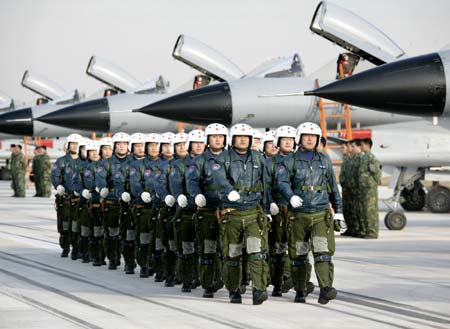China’s growing military might is forcing its neighbors to ramp up their defence spending but it will be decades before it rivals the United States as a military superpower, the IISS think tank said Wednesday.
Chinese military spending might match that of the US by the 2030s, the International Institute for Strategic Studies said as it launched its annual study of global military capabilities and defense economics.
However, China’s capabilities, expertise and ability to project power to the same level will take several more years to catch up, the institute’s experts said at their London headquarters.
Asian defense spending in 2013 was 11.6 percent higher than in 2010, in real terms, the IISS said. The largest absolute spending increases in the past year were in East Asia, with China, Japan and South Korea accounting for more than half.
China now spends around three times as much as India on defense, and more than neighbors Japan, South Korea, Taiwan and Vietnam combined.
“These outlays are fueling heightened military procurement in a region replete with conflicting territorial claims as well as long-standing potential flashpoints,” said IISS director-general John Chipman.
“Not least because of the Asia-Pacific’s central place in the global economy, the rapid pace of capability development and the potential for accidental conflict and escalation will continue to be of concern.”
China to match US spending by 2030s
The experts said that even when Beijing’s military spending catches up with Washington’s, it will take decades after that for its capabilities to match the United States.
Furthermore, Western powers may be able to retain their skills and abilities with smaller forces, which would push any crossover date further into the future.
Giri Rajendran, research associate for defense and economics, said that assuming China can maintain its current economic growth rates, China may be able to match US spending in the “mid to late 2030s”.
“Even if they start ramping up to a rough parity in the late 2030s, it will still be 20 to 30 years before you start approaching military parity,” he said.
The United States remained by far the world’s biggest defense spenders in 2013, with a budget of $600.4 billion, the report said, followed by China ($112.2 billion) and Russia ($68.2 billion).
Japan was seventh ($51 billion), India ninth ($36.3 billion) and South Korea 11th ($31.8 billion).
The IISS said Asian states were now developing and procuring advanced military equipment that used to be the sole domain of the West and Russia.
Christian Le Miere, the IISS naval forces and maritime security expert, said: “Territorial disputes, specifically maritime disputes, are certainly a driver of increasingly competitive military procurement in Asia.
“While they are the focus of many security concerns in Asia, they could more theoretically be seen as an outlet for the tensions being created by the rise of China.”
He added: “The United States remains the preeminent military power in the world — the only one able to deploy substantially.
“In terms of globally projectable forces, the Western powers will be the predominant military powers for decades at least.”
He said China’s approach to its maritime claims was one of “dispute management rather than dispute resolution”.
The IISS said tensions between China and Japan had risen substantially and they needed military-to-military consultations to reduce the risk of tactical encounters or a strategic crisis.
Land warfare expert Ben Barry said the rise of Chinese military power “should not be seen as wholly negative”, given that they were playing a growing role in UN peacekeeping operations and had participated in the international anti-piracy mission in the Indian Ocean.










